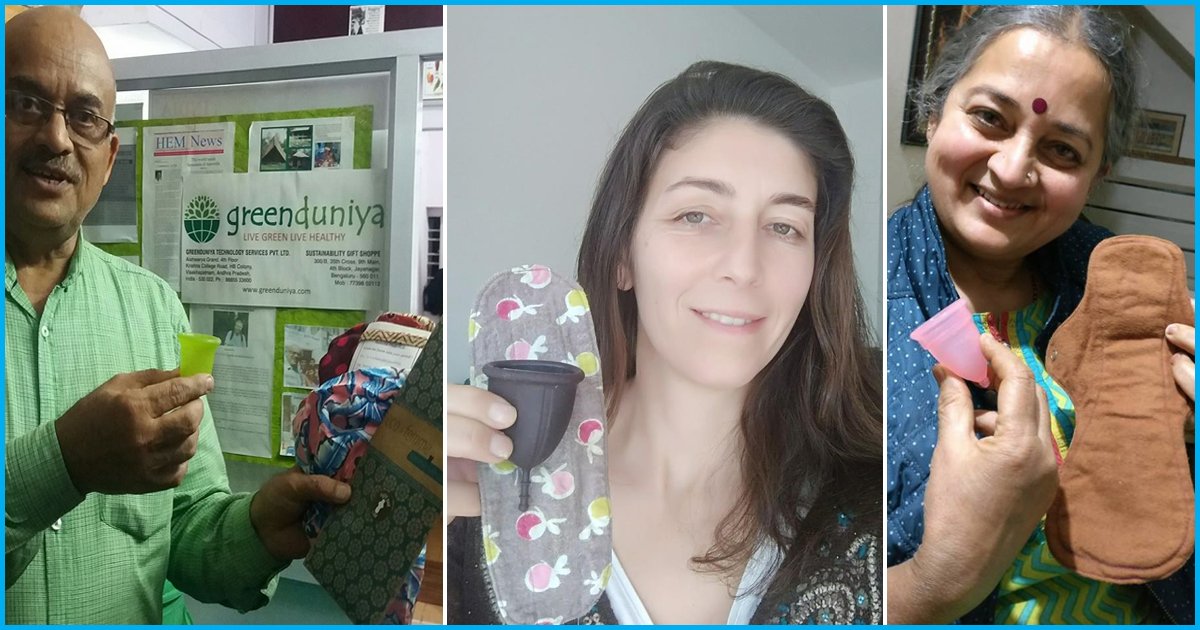
Use The #PadmanChallenge Started By Celebs To Create Awareness About Menstrual Cups, Cloth Pads
7 Feb 2018 9:58 AM GMT
Recently, many are taking to social media to break the stigma around menstruation. Taking the #PadmanChallenge, they posted their pictures with sanitary pads on Twitter, Facebook and Instagram, nominating friends and colleagues to do the same.
Thank you for tagging me @murugaofficial
Yes, that’s a Pad in my hand & there's nothing to be ashamed about. It's natural! Period. #PadManChallengeCopy, Paste this & Challenge your friends to take a photo with a Pad!
Here I am Challenging @aamir_khan @AzmiShabana @hvgoenka pic.twitter.com/QXYBwVfYV0
— Twinkle Khanna (@mrsfunnybones) February 2, 2018
Yes that’s a Pad in my hand & there's nothing to be ashamed about. It's natural! Period. #StandByHer
Copy, Paste this & Challenge your friends to take a photo with a Pad!
Here I am Challenging @akshaykumar @mrsfunnybones @sonamakapoor @radhika_apte pic.twitter.com/ULJuJmSeZN
— A Muruganantham (@murugaofficial) February 2, 2018
Thank you @mrsfunnybones
Yes, that’s a Pad in my hand & there's nothing to be ashamed about. It's natural! Period. #PadManChallenge. Copy, Paste this & Challenge your friends to take a photo with a Pad. Here I am Challenging @SrBachchan , @iamsrk & @BeingSalmanKhan pic.twitter.com/lY7DEevDmD— Aamir Khan (@aamir_khan) February 2, 2018
The campaign, though for the promotion of a movie, has the good intention of normalising periods in the Indian society.
Most of us use disposable sanitary napkins (DSNs) or tampons. We are sceptical toward using cloth pads, period panties, microfiber pads, menstrual cups, etc. because they are perceived as ‘unhygienic’. Why? Because instead of throwing away these products after each use, we need to wash and reuse them.
Green activists and concerned citizens accepted the #PadmanChallenge as an opportunity to spread awareness about sustainable menstruation. Cloth pads and menstrual cups are, in fact, much more hygienic than DSNs.
Yes that’s a cloth Pad in my hand & I don’t feel weird. It's natural, Period! And it is sustainable!!Challenge your…
Posted by Vani Murthy on Sunday, February 4, 2018
Yes, that’s menstrual cup and washable cloth pads in my hand & there's nothing to be ashamed about. It's natural for our…
Posted by Sunil Sood on Monday, February 5, 2018
Dear sustainable ladies and supporters of Green the Red, Please pose with your menstrual cup, cloth pad or any other…
Posted by Green the Red on Monday, February 5, 2018
Green challenge with an Indian pad and a French cup !Challenge your friends to take a photo with menstrual cup or cloth…
Posted by Claire Rao on Monday, February 5, 2018
Have you taken the #PadManChallenge yet?Here's how you can do it a little differently: Like #sustainablemenstruation…
Posted by Eartha on Monday, February 5, 2018
Why go the sustainable way?
When the world was less connected physically and when everything had to move in sync with the lunar and solar cycles, it is said that women used to indulge in self-care and collect the menstrual blood for fertilizing their fields. Unless the woman had any major infectious disease that could be transmitted by blood, this was perfect; soil with its moisture and microbial flora and sunlight, paved the way for quick decomposition of blood, and the minerals in it, just nourished the soil.
Today, in our fast-paced world, it is an ultimate comfort to be able to use disposable sanitary napkins (DSNs – also encapsulating here other MHM (menstrual hygiene management) options such as tampons, synthetic fleece etc., all which are disposed off after one-time use), but at what price? There are 3 major concerns about using DSNs:
- Health hazards to the user due to the chemical cocktail involved (dioxin, furan, pesticides and other endocrine disruptors).
- Environmental hazard due to non-biodegradable parts and chemical toxins – to every living being through direct handling, and indirectly through food chains.
- Social hazard due to the acceptability of disposables and shaming of reusables.
Disposable sanitary pads contain super-absorbent polymers mixed with bleached cellulose or synthetic pulp, which absorb moisture from skin – the primary cause of rashes. This is also the cause of Toxic Shock Syndrome due to over-exposing our body to tampons.
All the disposable pads that we use are white in colour because white is associated with hygiene and safety. DSNs are bleached with chlorine to give them the white colour thus, releasing dioxins during the process. When discarded pads are burnt or dumped in landfills, toxic dioxins reach the soil, water and air.
Sanitary pads and tampons contain also contain non-biodegradable plastic coating and add to the burden of municipal solid waste. Plastic does not biodegrade instead, breaks down into hazardous microparticles.
DSNs have no right way of disposal. Flushing them chokes the drains, burning releases toxins and dumping in landfill or water bodies is poisonous.
Most women use DSNs because they are convenient and there is little awareness of its hazards. We are either unaware of the alternative sanitary options available or sham the reusables.
But sustainable menstrual products are much more hygienic and does not pose environmental hazards.
[Read: Know About The Different Kinds Of Sanitary Napkins/Menstrual Pads]
Now that a discourse around the topic has been initiated, let us look at the alternatives and spread awareness about them. There is nothing unhygienic about washing your cloth pad or throwing the period blood that collects in a menstrual cup.
[Read: Know How To Choose And Properly Use Menstrual Cups]
Are you willing to take the sustainable menstruation challenge?
 All section
All section













